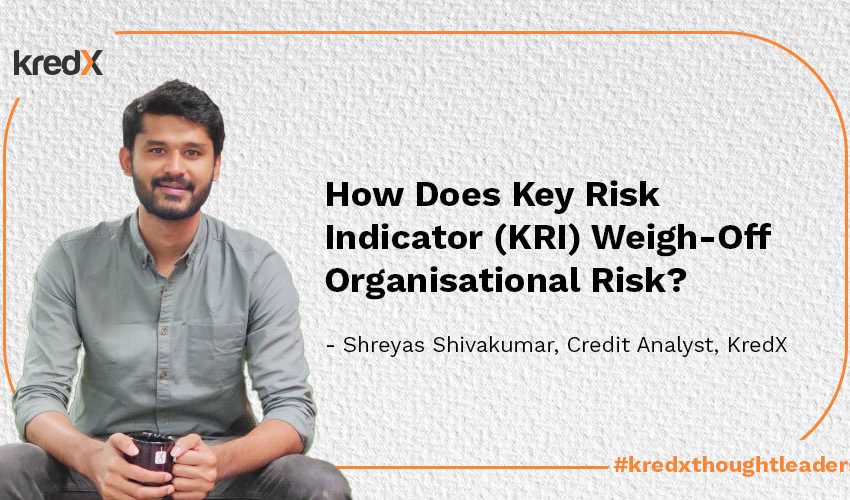
How Does Key Risk Indicator Weigh-Off Organisational Risks?
Key risk indicator (KRI) is an integral part of the risk framework, but how do they work and weigh-off risks from your business operations? In light of the same, we spoke to Shreyas Shivakumar, Credit Analyst, KredX, about the KRIs and its in an organisation, and here’s what he had to say.
With cash flow based lending gaining prominence, the risk management process has also improved over the last decade. Lending institutions have now started adopting different risk measures to evaluate the potential risks that the organisation can face. These risk measures can be a combination of different metrics depending on several factors within, and beyond the organisation. But what lays at the foundation of these measures is broadly known as Key Risk Indicators (KRIs). They help establish the core foundation of the risk policy of a company.
The fundamental goal of KRI is to act as a critical predictor for the future unfavourable events that can adversely impact the company. In addition to this, KRIs must also help devise mitigation strategies that help report risks and prevent crisis in a timely manner.
Development of KRIs requires a complete understanding of the company’s long-term strategy and risk-related events that can significantly impair the fulfillment of this strategy. Functional KRIs are the best set, when backed with high-quality data available from both internal and external sources, and are typically developed over a period of time sustainably. Once set, they have to be subjected to periodic reviews and regular tests to ensure that efficiency and coverage are maintained. KRI at all points must aim to re-adjust itself to the changing environment and dynamic circumstances in which it operates.
While the definition and structure of KRI differs from company to company, the overall goal of the exercise remains constant across the board. Every company can set KRIs depending on type of organisation, size, industry, product, term goals etc.
Common Features Of Effective KRIs:
Measurable:
KRIs must ideally be quantifiable and objective to help track and compare different metrics over a sustained period of time. Measurable risk metrics not only help update the metrics in line with changing environments but also help strengthen existing measures.
Predictable:
KRIs should contain a broad overview of potential future scenarios, both positive and negative. It helps to identify early warning signals and devise possible mitigants in case of adverse outcomes.
Comparable:
Creation of sustainable risk metrics is only useful when the practice is performed to learn through past and current experiences continually. KRI’s must always be sufficiently comparable to standards set internally or externally in order to assess the overall effectiveness of the KRI setting process over a sustained period of time.
Adaptable:
Business environment is constantly changing at a rapid pace, resulting in newer and complex scenarios of potential adverse outcomes. Unless the existing KRIs move in line with the changing business environment, they can often get obsolete and irrelevant, exposing the firm to adverse events for which no control measures/mitigants are in place. KRIs must be flexible enough for re-alignment with the changing environment.
Common Challenges Faced By Organisations While Installing And Implementing KRIs:
Inability To Define Standards:
Despite clarity on the broad risk metrics, there can be several instances wherein it becomes difficult to define standards that guide the risk management process. This may be due to the complex nature of risks involved or lack of yardstick to measure/compare risks.
Inadequate Control Measures:
Risk metrics set at the beginning must be followed up with adequate control measures without which the whole exercise becomes fruitless. Very often control measures, which are as important as the KRIs, become difficult to set, monitor, and follow.
Speed Of Change:
Re-adjusting the risk process in line with the changing environment can be a major impediment to a successful KRI setting process. One of the biggest hurdles in the risk management process today is the inability to keep up with change. Constant monitoring of the business environment through high-quality real-time data and information can often be expensive. Moreover, this would require a complex skill set and know-how, which many companies may not possess.
Technology Focus vs Risk Focus:
Integration of the risk process with technology may be a hindrance to the KRI setting process. It is possible that the focus may shift more towards technology features of the risk process rather than the risk process itself. Also, technology integration with risk processes may not be always successful, given the complex nature of the risk management process.
Management Awareness And Perception:
KRIs require coordination and agreement of several key members in an organisation, and that can be a major impediment to the overall KRI setting process. Very often control measures that are most easily understood or popular, get most of the management’s support, while other vital risks may be overlooked. It is also possible that due importance may not be given to the KRI setting process by the management, and sufficient resources may not be allocated for it.
Bottom line
Designing and setting KRIs are critical for the long-term sustainability of any organisation. The key design features and elements of KRIs must allow seamless integration with the governance culture and long-term goal of the company. While there may be many practical challenges in the KRI setting process as highlighted above, the benefits outweigh the challenges and help safeguard the company from potential adverse events.



